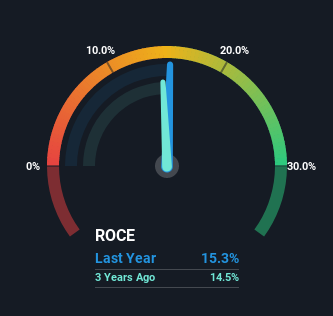- France
- /
- Professional Services
- /
- ENXTPA:BVI
Returns On Capital At Bureau Veritas (EPA:BVI) Have Hit The Brakes

If you're looking for a multi-bagger, there's a few things to keep an eye out for. In a perfect world, we'd like to see a company investing more capital into its business and ideally the returns earned from that capital are also increasing. Put simply, these types of businesses are compounding machines, meaning they are continually reinvesting their earnings at ever-higher rates of return. With that in mind, the ROCE of Bureau Veritas (EPA:BVI) looks decent, right now, so lets see what the trend of returns can tell us.
Understanding Return On Capital Employed (ROCE)
If you haven't worked with ROCE before, it measures the 'return' (pre-tax profit) a company generates from capital employed in its business. The formula for this calculation on Bureau Veritas is:
Return on Capital Employed = Earnings Before Interest and Tax (EBIT) ÷ (Total Assets - Current Liabilities)
0.15 = €756m ÷ (€7.1b - €2.2b) (Based on the trailing twelve months to June 2022).
Thus, Bureau Veritas has an ROCE of 15%. On its own, that's a standard return, however it's much better than the 12% generated by the Professional Services industry.
Our analysis indicates that BVI is potentially undervalued!

In the above chart we have measured Bureau Veritas' prior ROCE against its prior performance, but the future is arguably more important. If you'd like, you can check out the forecasts from the analysts covering Bureau Veritas here for free.
So How Is Bureau Veritas' ROCE Trending?
The trend of ROCE doesn't stand out much, but returns on a whole are decent. The company has consistently earned 15% for the last five years, and the capital employed within the business has risen 25% in that time. 15% is a pretty standard return, and it provides some comfort knowing that Bureau Veritas has consistently earned this amount. Stable returns in this ballpark can be unexciting, but if they can be maintained over the long run, they often provide nice rewards to shareholders.
The Bottom Line
The main thing to remember is that Bureau Veritas has proven its ability to continually reinvest at respectable rates of return. In light of this, the stock has only gained 11% over the last five years for shareholders who have owned the stock in this period. So because of the trends we're seeing, we'd recommend looking further into this stock to see if it has the makings of a multi-bagger.
One more thing, we've spotted 2 warning signs facing Bureau Veritas that you might find interesting.
If you want to search for solid companies with great earnings, check out this free list of companies with good balance sheets and impressive returns on equity.
Valuation is complex, but we're here to simplify it.
Discover if Bureau Veritas might be undervalued or overvalued with our detailed analysis, featuring fair value estimates, potential risks, dividends, insider trades, and its financial condition.
Access Free AnalysisHave feedback on this article? Concerned about the content? Get in touch with us directly. Alternatively, email editorial-team (at) simplywallst.com.
This article by Simply Wall St is general in nature. We provide commentary based on historical data and analyst forecasts only using an unbiased methodology and our articles are not intended to be financial advice. It does not constitute a recommendation to buy or sell any stock, and does not take account of your objectives, or your financial situation. We aim to bring you long-term focused analysis driven by fundamental data. Note that our analysis may not factor in the latest price-sensitive company announcements or qualitative material. Simply Wall St has no position in any stocks mentioned.
About ENXTPA:BVI
Bureau Veritas
Provides laboratory testing, inspection, and certification services.
Excellent balance sheet with proven track record and pays a dividend.


